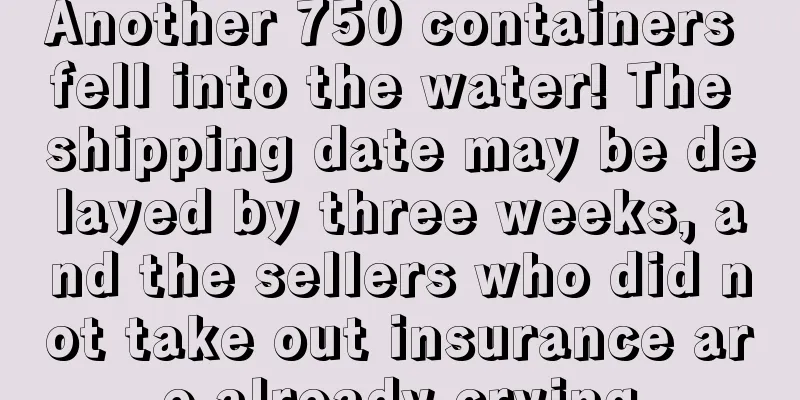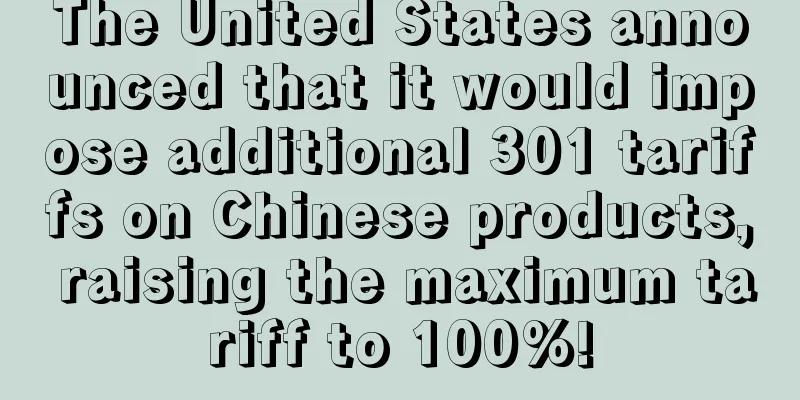Another 750 containers fell into the water! The shipping date may be delayed by three weeks, and the sellers who did not take out insurance are already crying

|
The ship has called at ports such as Hong Kong, Yantian, Xiamen, and sailed to the Port of Los Angeles in the United States. In addition to MAERSK, the shipping companies that may share the cabins include ALIANÇA, HAMBURG SÜD, HAPAG-LLOYD, MCC, SAFMARINE, SEAGO, SEALAND, etc. Recently, Mediterranean Shipping Company further disclosed the situation in its latest announcement. AP Moller - Maersk (Maersk Group), a multinational shipping giant headquartered in Copenhagen, Denmark, issued a statement saying that on the 16th of this month, the Maersk Essen cargo ship lost about 750 containers on its way from Xiamen, China to Los Angeles, the United States. It is understood that the number of containers damaged and lost at sea in this accident is higher than expected; a total of about 700-750 containers fell into the water, about half of which were MSC's customer containers. In addition, it is understood that there are dozens of damaged MSC containers on board. In addition to the general average and recovery issues that may arise due to cargo loss and/or damage, all other cargo will also experience significant delays, which may adversely affect time-sensitive or refrigerated cargo on board. Currently, all crew members are safe and the ship is continuing its voyage while a detailed assessment of cargo losses is being conducted. On January 29, the Maersk Essen is expected to dock at the Port of Lazaro Cardenas in Mexico for cargo inspection, port operations and repairs. Maersk said the ship was flying the Danish flag. After the accident, the company has notified the U.S. Coast Guard, the flag state and relevant national government departments. "We believe this is a very serious situation and we will investigate it quickly and thoroughly." In fact, there have been many similar accidents in previous years, and quite a few containers have fallen into the sea. In the early morning of January 2, 2019, a super large container ship named "MSC Zoe" owned by Mediterranean Shipping Company encountered severe weather in the North Sea, and a large number of containers fell into the water, with nearly 270 containers lost. At that time, the ship was fully loaded with goods from Shanghai Port, Ningbo Port, Tianjin Port and Shenzhen Port in China to Europe, with a cargo volume of up to tens of thousands of containers, including multiple dangerous goods containers. The Wall Street Journal said that the loss of containers in bad weather is relatively rare, but accidents are on the rise this winter, especially in the Pacific. According to a report by the World Shipping Council in July last year, an average of 1,382 containers were lost at sea each year from 2008 to 2019. But in the past two months, about 3,000 containers have been lost at sea. The main reasons behind this are the bad weather in the Pacific region, the increase in voyages due to high freight rates, and the increasingly large cargo ships. Bloomberg said that this year, as international shipping freight rates soared to record highs and major companies needed to restock their inventories, container ships loaded with goods sailed from China to the United States. Other professionals told the Wall Street Journal that these other reasons may be related to the failure of the container lashing system on the ship. As ships become larger and containers are stacked like high-rise buildings, the stability of the ship may be subject to greater pitching and swaying pressure. Greek shipbuilding engineer Fotis Pagoulatos said that this phenomenon is called "parametric rolling", which often occurs when the wave hits the bow at an angle instead of being head-on. As the wave rises and falls, the ship begins to sway, which, combined with the normal bumps of the ship as it moves forward, may cause the container to shift. Lars Jensen, CEO of Denmark's SeaIntelligence Consulting, also said that the demand for shipping has been high recently and the ships are full of cargo. The higher the containers are stacked, the greater the force they will be subjected to when the ship is swaying, and the more likely they are to fall. Bad weather is considered force majeure, and the carrier is exempt from liability, but cargo transportation insurance can cover it. Therefore, if you have purchased cargo transportation insurance, you can file a claim with the insurer. If you do not have insurance, you will probably be in tears, which is simply adding insult to injury. Export cargo transportation insurance usually has ICC (A) as its underwriting terms, which means all risks. It covers natural disasters. Any cargo loss caused by containers falling into the sea due to bad weather can be claimed from the insurance company. So, if a container falls into the sea, can the carrier be exempted from liability? Today, Xiaohei will show you a historical litigation case: If the cargo it was carrying fell into the sea due to its own carelessness in driving the ship, can the carrier enjoy "exemption from liability" on the grounds of encountering a typhoon? Recently, a shipping company asked the Shanghai High People's Court to withdraw its appeal application, recognize the first-instance judgment of the Shanghai Maritime Court, and bear the losses caused by the cargo management errors of its ship. At about 9:00 pm on August 29, 2000, the CMA CGM Tania, a ship owned by the French shipping company CMA CGM, loaded more than 3,000 containers at Shanghai Port and set sail for Ningbo. In the early morning of the next day, the CMA CGM dropped anchor at the Yangtze River estuary due to the approaching typhoon "Pabion". At noon, the captain decided to weigh anchor and leave the anchorage based on the typhoon's moving direction reported by the weather forecast. At 6:20 pm, the CMA CGM weighed anchor and adjusted its course at any time during the voyage according to the wind direction. Unexpected events happen. At 1:45 a.m. on August 31, the CMA CGM entered the eye of the typhoon, and the ship rolled violently by 30 degrees. A total of 25 20-foot containers and 94 40-foot containers fell into the sea. At 4:30 p.m. that day, the ship finally arrived at Ningbo Beilun Port. The relevant parties later salvaged some containers, but they were severely deformed, dented or twisted. Since April 2001, cargo owners of various foreign trade companies and insurance companies that have obtained subrogation rights (the right to seek compensation on behalf of the cargo owners) have sued France's CMA CGM Shipping Company in the Shanghai Maritime Court for maritime cargo transportation contract disputes. The court has accepted 15 cases in total. Many plaintiffs claimed that the captain of the CMA CGM had been informed of the Typhoon Pabian warning before sailing, but did not take reasonable measures to avoid the wind. The captain's driving negligence was obvious, and the shipowner was responsible for appointing such an unqualified captain. Secondly, the defendant shipowner did not fulfill its obligation to carefully manage the cargo. Based on this, the plaintiffs asked CMA CGM to bear the liability for cargo damage or negligence caused by the container falling into the sea. CMA CGM argued that the CMA CGM Tanya ran into the eye of a 12-level typhoon, which caused the containers on the deck to fall into the sea. Before raising the anchor, the crew on board had already secured all the containers, but the violent rolling of the ship made the securing ineffective. Since the loss was caused by force majeure, the carrier can be exempted from liability according to law. CMA CGM also proposed that even if the captain and crew were at fault in driving and managing the ship, the carrier could cite the relevant provisions of the Hague Rules to claim exemption from liability. More than 100 containers fell into the sea. Was it caused by the typhoon, or was it due to improper driving of the crew, or was there another reason? The presiding judge Ni Yong told reporters that it was an indisputable fact that the CMA CGM Tanya, owned by CMA CGM, encountered a typhoon, but the shipowner must meet the prerequisites for exemption in accordance with the law in order to enjoy exemption in accordance with the law, that is, the carrier CMA CGM should properly and carefully load, move, stow, transport, keep, take care of and unload the transported goods. The court also found that although CMA CGM provided the loading and unloading company with instructions for securing containers below 3 layers in accordance with the requirements of the Container Securing Manual, it failed to provide evidence to prove that reasonable lashing measures were taken for containers above 3 layers on the deck, and failed to fulfill its responsibility of careful loading. Based on this, the court ruled that CMA CGM could not be exempted from liability and should bear the responsibility for cargo damage caused by the container falling into the sea. CMA CGM was dissatisfied with the first-instance judgment and filed an appeal. The Shanghai High People's Court further found during the trial that the CMA CGM seriously violated the requirements of the Container Securing Manual during the loading of containers on the third deck, causing the first deck containers to deform and fall into the sea due to vertical pressure exceeding the permitted bearing capacity during the swaying of the ship. Recently, the appellant, CMA CGM Ltd., submitted an application to withdraw the appeal to the Shanghai High Court, and the court approved the withdrawal. Why can’t CMA CGM be exempted from liability when its container falls into the sea? Although the ship encountered "force majeure" such as the 12-level "Pabion" typhoon, according to relevant international and domestic laws and regulations, the captain and crew can be exempted from liability for negligence in driving and managing the ship, but the court still ruled that the French CMA CGM Shipping Company, to which the "CMA CGM Tanya" belonged, should bear the responsibility for the loss of cargo. Why? Judge Ni Yong, the presiding judge of the case panel, said that although Article 107 of the General Principles of the Civil Law of the People's Republic of my country stipulates: "If a contract cannot be performed or damages are caused to others due to force majeure, no civil liability shall be borne, except otherwise provided by law." However, the fall of hundreds of containers into the sea was not entirely caused by the typhoon. The subjective mistakes of the captain and crew were also an important reason. In its defense, CMA CGM argued that since it was written on the back of the bill of lading, the Hague Rules (International Convention for the Unification of Certain Rules of Law Relating to Bills of Lading, signed in 1924) would apply if a contract dispute occurred. According to the Hague Rules, the captain and crew can be exempted from liability if they make mistakes in driving and managing the ship. Citing the Hague Rules, Article 51, Paragraph 1 of my country's Maritime Code also has similar provisions. Judge Ni Yong first denied the applicability of the Hague Rules: "The bill of lading with the terms printed on the back is a form bill of lading unilaterally printed by CMA CGM, and CMA CGM cannot prove that the plaintiff and the defendant had negotiated before the shipment of the goods, so the case should be governed by the law of the country that has the closest connection with the contract, that is, Chinese law." According to the Maritime Code, if the container fell into the sea entirely due to the crew's mistakes in driving and management, CMA CGM can also be exempted from liability. However, after investigation and evidence collection, Judge Ni Yong denied the "sailing error theory" and determined that the main reason for the fall into the sea was not this, but the relevant personnel's mistakes in the management of the goods, that is, they failed to provide evidence to prove that reasonable lashing measures were taken for containers above the third deck and failed to fulfill their responsibility of careful loading. According to the evidence collected by the Shanghai High Court, the "CMA CGM" seriously violated the requirements of the "Container Securing Manual" during the loading of containers above the third deck, which further proves that the main reason for the goods falling into the sea was improper cargo management. Swipe up and down to view According to estimates by freight forwarders, shipping will not return to normal until after August this year . Can you still hold on? |
Recommend
Hot market! It is predicted that the ownership rate of smart products in the United States will increase significantly by 2025!
It is learned that according to eMarketer's fo...
When applying for a high-paying operations position at Amazon, and you are asked about keyword embedding methods, here is what you should say!
The peak job-hunting season of March and April 202...
What is Kuazhitong? Kuazhitong Review
Kuazhitong is the first cross-border intellectual ...
Big news! After selling Paton, Cross-border Communication once again...
In January, Cross-border Communication issued the ...
What is the International Trade Center? International Trade Center Review
The International Trade Centre (ITC, French: Centr...
Amazon banned your product for variant violation? Let’s find out more about variants!
There are more and more cases of sellers having th...
What is FHDDS? FHDDS Review
FHDDS is a legal requirement in the UK. Companies ...
Always be alert to the top ten common mistakes in Amazon operations, because I fell into the trap!
1. Risk of association when one person operates m...
What is WooRank? WooRank Review
WooRank is a website analysis tool that scores web...
How to create anti-hijacking links?
What? What is anti-hijacking link? Simply put, as ...
What is KONIGLE? KONIGLE Review
KONIGLE App allows sellers to reprice products to ...
What is Via? Via Review
Via was founded in 2012 and provides on-demand and...
CPSC recalls 200 stacking toys for children due to excessive lead content!
<span data-shimo-docs="[[20,"铅含量超标!CPSC召回2...
How to make $3,000 a day by developing a hit product for Amazon!
Some time ago, cross-border sellers successively r...
Amazon is only online for refunds, how can sellers turn off refunds without returns?
Amazon sellers, please fasten your seat belts, bec...









